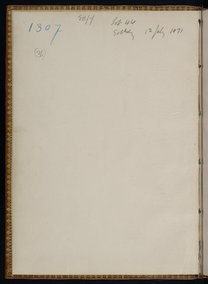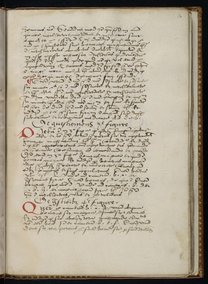Ars brevis and Ars abbreviata praedicandi, versio latinus II
- Circa 1490 – 1550 ((Ars Brevis))
- Circa 1490 – 1520 (Ars abbreviata praedicanda)

Rights
Download all 86 images
PDFZIPof full-sized JPGsDownload selected image
Small JPG1200 x 1638px — 586 KBLarge JPG2880 x 3931px — 3.2 MBFull-sized JPG3630 x 4955px — 4.7 MBOriginal fileTIFF — 3630 x 4955px — 51.5 MBThis manuscript includes two texts by notable Catalan philosopher, theologian, and mystic of the High Middle Ages, Ramon Llull (Ramon Llull or Raimundus Lullus; 1232-1316), Ars brevis, and Ars abbreviata praedicandi.
Llull explained his system of thought, his great “Art,” in many works over the course of his life. Perhaps the most influential was the Ars brevis, written in Pisa c. 1307-1308. In Llull’s words, “the subject of this art primarily consists in demonstrating the truth of the holy Catholic faith…to those who are ignorant of it, as well as reassuring those who already know and believe it…” He constructed a system of thought attempting to prove Christian mysteries such as the Incarnation and the Trinity using arguments acceptable to the faith not only of Christian believers, but also to those of Islamic and Jewish faith. An integral part of the text of the Ars brevis are a number of charts and figures. Though the Ars brevis was broadly disseminated, Llull’s initial works explaining his “Art” were not greeted warmly by his contemporaries.
Ars abbreviata praedicanda is one of several Latin treatises Llull composed on preaching between 1312-1313. His aim to reach audiences who were not Christian was reflected in his theory of preaching; he sought to replace the use of authorities from scripture with a system of moral instruction that would be accepted not only by Christians, but also by non-Christians.
This Latin text exists in three different renderings. The Othmer Library holds the second rendering, or, versio latinus II. The manuscript is bound in modern light brown morocco, spine with four raised bands, and "1307," in gilt, turn-ins tooled in gold with marbled endpapers.
| Property | Value |
|---|---|
| Author | |
| Provenance |
1. Both texts can be dated between the 15th century to the first half of the 16th century. Likely copied in Germany or Southern Netherlands. [1] 2. Clipping from Sotheby sale, 12 July 1971, lot 44 laid in; front flyleaf Show notes[1] The watermark found on the paper used for the Ars brevis circulated over a long span of time from the late fifteenth century through 1549, mostly in the southern Netherlands, but also in France, and possibly Czechoslovakia. The watermark associated with the Ars brevis praedicandi does seem to support a date between 1490 and 1520 for this text, but it was distributed over a very broad area of Germany. The two texts are preserved in a modern binding; it is unclear how long they have been bound together. This copy of the Ars abbreviata praedicandi, which was written in 1312/3, puzzlingly transcribes the date of the text as 1307. Was the scribe influenced by the date of the Ars brevis, a text which was composed in 1307/8? If so, then this might be seen as an argument that both these texts circulated together from an early date. Both texts were copied by different scribes and on different lots of paper. The first folio of the second text is darkened, suggesting it was once at the beginning of a volume, despite the fact that it now begins imperfectly. Both sections have some staining in the outer margins from damp, etc., but with rather different patterns. Therefore, although it is not altogether impossible that both these texts were part of the same manuscript from an early date, it seems more likely that they have independent origins, and were brought together later. |
| Place of creation | |
| Format | |
| Genre | |
| Extent |
|
| Language | |
| Subject | |
| Rights | Public Domain Mark 1.0 |
| Credit line |
|
Institutional location
| Department | |
|---|---|
| Collection |
Related Items
Cite as
Llull, Ramon. “Ars Brevis and Ars Abbreviata Praedicandi, Versio Latinus II,” circa 1490–1550. https://digital.sciencehistory.org/works/txt90sk.
This citation is automatically generated and may contain errors.






















































